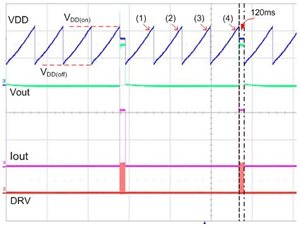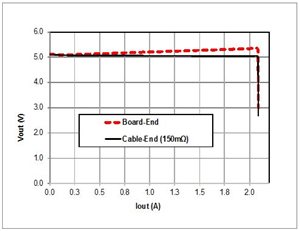SSZTAT4 october 2016 UCC28704
USB Type-C™ is upon us, representing the most significant change to USB that most consumers will notice to date. On top of a new reversible connector, the maximum power has increased to 15W. Higher wattage makes it difficult to design power adapters that meet the required efficiency and standby power standards while maintaining the small form factor that customers expect. But it is not impossible, since new flyback controllers such as the UCC28704, which TI released earlier this year, further improve performance and include many advanced features for USB Type-C chargers.
CCUV
 Figure 1 Soft-short Protection
Figure 1 Soft-short Protection Figure 2 Output v -1 Curves
Figure 2 Output v -1 CurvesEfficiency Boost
- An increased maximum demagnetizing time ratio (Dmag) to 0.475. This increase mainly helps reduce secondary-side peak current and RMS current for the same rated output current to boost efficiency. This helps to achieve higher efficiency at heavy (75%) and full (100%) loads.
- Two techniques boost efficiency at 10%, 25% and 50% loads:
- Enabling light to medium load-switching frequency at about 25kHz to reduce switching losses while avoiding audible noise.
- The introduction of a “wait” state to shut off internal unused circuits, thus reducing the device’s bias energy at light to medium loads.
As Table 1 shows, the UCC28704 in TI Designs Universal AC Input to 5V 3A Output Reference Design DOE VI and CoC V5 Tier 2 2016 Compliant (PMP15002) can meet these standards with a 150mΩ cable, while passing both conducted and radiated electromagnetic interference (EMI) while not sacrificing size or cost. These benefits are not limited to 15W, and as TI Designs Universal AC Input to 5V 2A Output Reference Design CoC Tier 2 2016 Compliant (PMP11612) shows, the UCC28704 can achieve the same high performance at 10W as well. By enabling such high efficiency, the latter reference design meets DoE Level VI and CoC V5 Tier 2 efficiency with a diode on the output, enabling a very low-cost solution, which reducing the cost from where an SR MOSFET with driver device has to be used in alternative solutions.

|
Besides the reference designs, other design tools available on the UCC28704 product page include a SPICE model, WEBENCH® Designer calculator, Excel calculator, MathCAD calculator, UCC28704EVM-724 evaluation module and a user’s guide.